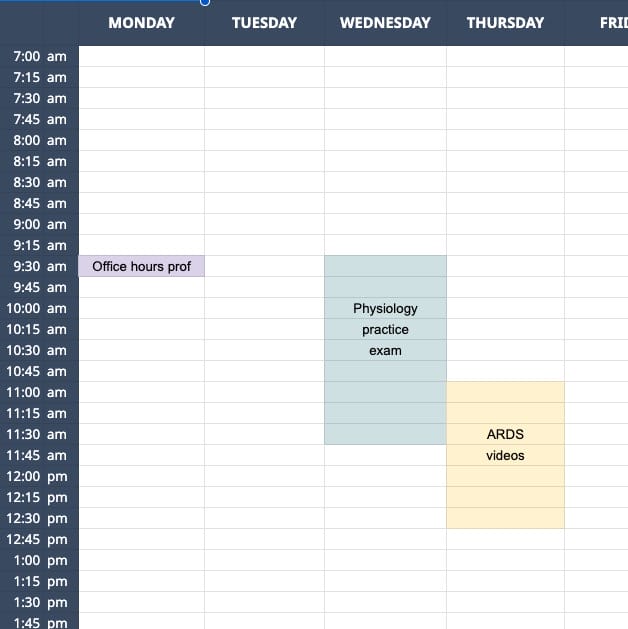What is time blocking?
Time blocking is a time management technique with the goal of making you more productive. You time block by dividing your day into blocks of time, with each block being dedicated to a specific task.
How does the time blocking method work?
Maybe you know this situation: You want to sit down and study productively, but your study session somehow spirals into chaos, you feel unorganized, unfocused, and unproductive, asking yourself what you are doing wrong. One of the culprits is probably a reactive approach to time management.
What does that mean? On a typical day, a lot of students switch between tasks constantly, reprioritize topics on the fly, and spend all day reacting to an endless stream of new inputs. Whether it’s text messages from fellow students, an urgent email from your professor or student job, or a sudden priority task popping up, the continuous need to reassess what to do next can drain your energy and scatter your attention.
You react to external prompts and adjust your priorities instead of following through with a set plan of your own. This can make it hard to maintain momentum and achieve the deep focus necessary for effective learning.
Pros of time blocking
According to Medium, a lot of successful people like Steve Jobs, Elon Musk, and even Benjamin Franklin swore by time blocking to maximize their efficiency. The main benefits of allocating specific time blocks to specific tasks each day are:
- Minimized task-switching: Task-switching depletes your energy and concentration. Working through the preplanned time blocks and sticking to them keeps you from jumping between tasks, getting distracted, and losing focus.
- Increased awareness of your time management: Since you’ve planned specific durations for tasks, you directly see if the allocated time was sufficient or not. This way you can
- Reduced anxiety and overwhelm: Having blocked specific times for specific tasks frees you of the responsibility to decide constantly what is important to do next. Your plan for the day or week is set, the planning is done, making your day predictable, which can feel less overwhelming.
- Enforced prioritization and goal-setting: Planning out your time blocks in advance forces you to take the time to prioritize your tasks according to your goals in a structured manner. What is important? What is urgent? What’s next? This places your work sessions in context of your progress and you always know where you stand.
- Clearer boundaries between work and life: Whether you time block only during your work times, or include all your free time activities as well – your work or study stays within its allocated time blocks. This makes it easier to shut off at the end of the day and separate your work and your free time.
“Why time blocking doesn’t work” (…for everyone)
One of the biggest downsides of time blocking (and why some say it is not helpful) is the lack of flexibility. Life happens, and unexpected tasks or prolonged activities can throw off your entire schedule.
Another risk is that if you frequently underestimate how long tasks will take and end up with an over-packed schedule, constantly having trouble following through with a plan can lead to unnecessary frustration.
Last but not least, not everyone is the same: While for a lot of people, having a clear plan feels relieving, it can feel overwhelming or restrictive for others. Students who thrive on spontaneity may feel more constricted and stressed by a rigid schedule and may actually be more productive when going with the flow.
We recommend trying it out! The key to a sustainable and effective study routine is to not work against yourself, but finding methods that work for you and that you can stick to easily.
How to time block for studying
#1 Make a list of your tasks
Start off by listing out all the things you need to do or learn. You can do this for one day, the upcoming week, or even the next month. Make sure to include one-offs as well as recurring tasks.
#2 Prioritize
Mark the tasks according to their priority. Priority can be determined by importance and/or urgency. You can, for example, use a numbered or a color system for this.
#3 Estimate times
For each task, make an estimate of how long you think it will take. Here are some tips how to do this effectively:
- Be realistic: We all frequently underestimate the duration of tasks. We are humans, not robots!
- Add buffers: Adding buffer time before or after tasks can account for any spillover and help you stick to the schedule.
- Include breaks: Scheduled breaks are super important. You can follow a technique like the Pomodoro method, scheduling 5-minute breaks after each 25 minutes of work, or a different rhythm that works for you.
#4 Build the schedule
Use your favorite calendar app to block out time chunks for each task. Typically, it makes sense to make a block at least 15 minutes long, and not longer than a few hours – if a task block lasts all day, you could probably go more granular with breaking up the task or scheduling in breaks.
What if you fall off the schedule?
At the end of the time period you created the schedule for, sit down and take a little time to review: What worked? What didn’t? Adjust your time blocks for the next day or week accordingly.
If you notice during the day that you cannot stick to the schedule, have a plan in place how you react to this. Instead of completely discarding your plan, take a minute to pause and calmly reassess and reprioritize:
- Look at the tasks you have left for the day and reprioritize. Which ones can be postponed?
- Rearrange your leftover blocks to a plan that is doable and stick to that.
- If you cannot postpone any times, you might have to adjust the expectations or scope of the tasks to be able to do them in a shorter time block. Sometimes, a “good enough” is truly good enough and better than completely falling behind.
- If you have the time, identify why you fell behind schedule. You can also just quickly note this down and come back to it at the end when you evaluate how your schedule went, and improve the next one.
- Don’t forget to notify others if your change of schedule might affect someone else’s.
Weekly time blocking template (Free Google Sheet)
Click on the link to copy our free weekly time blocking template. You will be asked to sign into your Google account, and then be prompted to create a copy of the template to start using it.
The template includes a section for listing out your tasks, as well as a layout of the week with time slots in 15-minute intervals.

Free weekly time blocking Google sheet template
Click the button to copy the template and use it to create your own time blocking plan for the week!
The best time blocking apps for students
The best time blocking app of course depends on individual preferences – do you prefer full flexibility, do you need a bunch of other tools to integrate, or do you prefer the app to take over as much of the scheduling as possible? Here are some popular options, but there are plenty more to try.
Notion
Notion is a notes and task organization app that gives you a lot of flexibility with how you want to organize your time blocking. You can freely set up a daily or weekly planner as a table, calendar, or board. It lets you attach detailed notes, links, and documents to the tasks, making it easy to keep everything you need in one place. It can also send you reminders and integrate with other tools like Google Drive. The free version gets you far.
Motion
Motion (with an M) is a tool with a smart algorithm that automatically plans your day and tasks for you, considering your priorities. It reschedules and breaks up tasks automatically, so you never have to postpone anything yourself – it just moves tasks that are not done yet to the next available slot and warns you if you exceed a deadline. A paid account is about 19$ for a yearly individual plan.
Akiflow
Akiflow is an app specifically designed for time blocking. It mirrors the time blocking process the most directly, letting you first create tasks that you then drag into a calendar.
How to time block on Google calendar
Another free option is using Google calendar. You can create a separate calendar for time blocking for your tasks. Just add an event for each task, and use the color coding options to quickly see the types of tasks you need to do at a glance. Recurring tasks can be set as recurring events.
Lecturio’s Study Planner
If you’re a medical or nursing student, the Lecturio platform has a built-in planner feature. The Study Planner lets you add exam prep schedules, videos, or topics from the Lecturio learning platform to your to-do list and tracks your progress until your next exam. Sign up for free to try it out →
Not an app, but a physical planner
Some of us just work better with a paper planner that they can touch and keep on their desk. Productivity expert Cal Newport has developed a planner specifically for time blocking, but you can make every planner work that has pre-sectioned days, weeks, or months into chunks. Take care to choose one that has enough space for you to subdivide the chunks and fill in your task details. Note that one downside of a physical planner is that you can’t as easily adjust and delete entries like you can with digital options.




